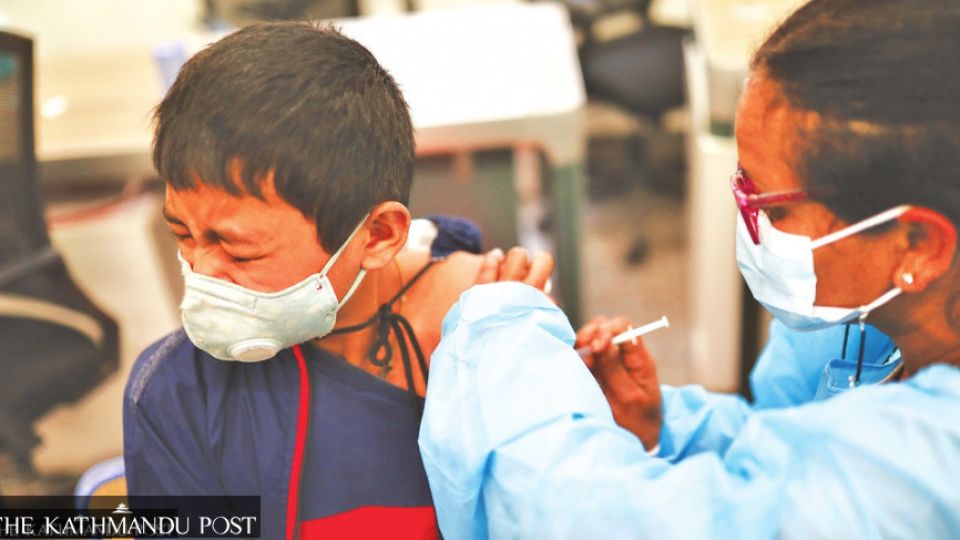June 29, 2022
KATHMANDU – Thousands of children aged between five and 11 from 27 districts, where vaccination against Covid-19 was launched on June 23, have been deprived of jabs, which officials say due to lack of sufficient doses.
According to Health Office Lalitpur, the vaccination campaign has been halted before the deadline.
“We could not administer the jabs to around 30,000 children of the said group in Lalitpur Metropolitan City, Godawari Municipality and Mahankal Rural Municipality,” said Satish Bista, chief of Health Office Lalitpur. “We had demanded 80,000 doses but got only 50,000 doses.”
The first phase of the immunisation campaign against Covid-19, designed for children between five and 11 years, started in 27 districts on Thursday after Nepal received around 2.2 million pediatric doses of Pfizer-BioNTech vaccine..
The weeklong campaign was supposed to continue until Wednesday.
In the first phase, children of the said age group in Jhapa, Ilam, Morang, Sunsari, Saptari, Dhanusha, Parsa, Siraha, Mahottari, Kathmandu, Lalitpur, Bhaktapur, Chitwan, Kavrepalanchok, Sindhuli, Makawanpur, Kaski, Nawalparasi West and Nawalparasi East are to be inoculated.
Other districts in which the vaccination drive has been launched in the first phase are
Rupandehi, Banke, Dang, Bardiya, Surkhet, Kailali, Kanchanpur and Dadeldhura, according to Health Ministry officials.
Officials at the Health Ministry concede that thousands of children might have been deprived of the vaccine.
They, however, said that all eligible children will be inoculated once additional doses of vaccine arrive.
“Several districts have reported about the vaccine shortage,” said Dr Samir Kumar Adhikari, joint spokesperson at the Health Ministry. They will continue the vaccination once additional vaccine doses arrive.”
The Health Ministry had estimated that there are around 2.2 million children of the said age group in the 27 districts, in which the first phase of the campaign has been launched. However, the shortage of vaccine doses shows that the number of children between five and 11 is more than the estimate.
“Actual number of children differed from our estimation,” said Adhikari. “ children who could not get the jabs due to dose shortages will be inoculated once we receive additional doses.”
Sagar Dahal, chief of National Immunisation Programme said that even if the first phase of the campaign is scheduled for one week (from June 23 to 29), local health facilities can extend the programme as per the local needs.
Officials at the Logistic Management Section under the Department of Health Services said that 2,299,200 doses of vaccine doses are scheduled to arrive on July 3.
“Those vaccines will be used for the first and second dose,” said Dr Surendra Chaurasia, chief of the Section. “Those who did not get the first dose will get the first dose and those who have been administered with first dose will get the second dose.”
The second dose of the vaccine will be administered from July 18 to 24 in the 27 districts.
The Health Ministry said that the second phase of the campaign will be launched from August 21 to 27 in the remaining 50 districts.
Nepal received 2,203,200 million Pfizer doses of Covid-19 vaccine from the COVAX facility on Sunday.
The vaccine doses are part of the 8.4 million doses committed by the facility, which is the United Nations-backed international vaccine-sharing scheme. The United States government bore the cost of the vaccine doses and the USAID facilitated the supply, according to officials.
There are two types of Pfizer-BioNTech Covid vaccines for children—one is for those between five and 11 years, and another for those aged 12 and above. Nepal has already used Pfizer vaccines on those with comorbidities and on children between 12 and 17 years.
The Pfizer-BioNTech vaccine is the only jab recommended by the World Health Organization for use in children between five and 11 years old.
The American Association of Paediatrics has recommended administering 10 microgram doses in a gap of 21 days to children between five and 11 years. The dose, 0.2ml, is one-third of what is administered to adolescents and adults.
The vaccine vial for 5-11 year olds comes with an orange cap while the other vial is purple-capped.
Each vial with 10 doses needs 1.3 millilitres (ml) of diluent under Pfizer’s preliminary plan.
The US Food and Drug Administration in October authorised emergency use of the Pfizer-BioNTech Covid vaccine in children between five and 11 years. Several countries have already started administering the vaccine to children.
Although the Pfizer doses for adults can be kept in normal temperatures (2 to 8 degrees Celsius) for up to 31 days, paediatric doses can be stored in normal temperatures for up to 10 weeks, officials said.
Nepal has so far received 55,584,770 doses of Covid vaccines of various brands—AstraZeneca, Vero Cell, Moderna, Janssen, Sinovac-CoronaVac, and Pfizer-BioNTech, including paediatric doses.
As many as 20,267,818 people or 69.4 percent of the total population have been fully immunised so far.
After a decline in cases, infections have risen lately in Nepal.
On Tuesday, 44 people tested positive for Covid-19 (38 in 1,552 in polymerase chain reaction tests and six in 946 antigen tests).
The number of active cases stands at 229 throughout the country.


